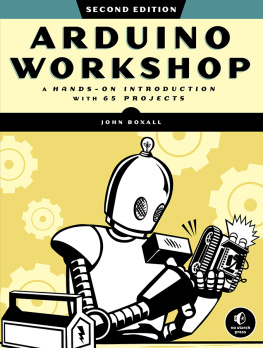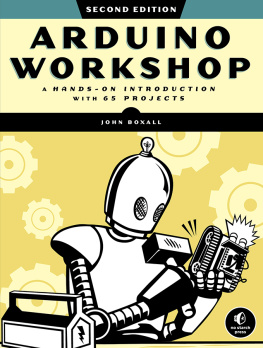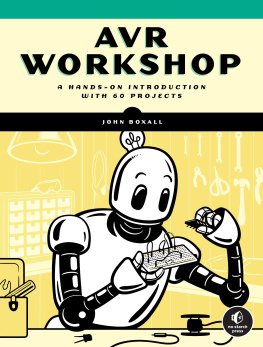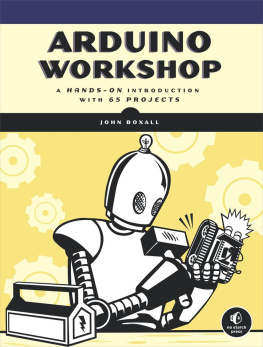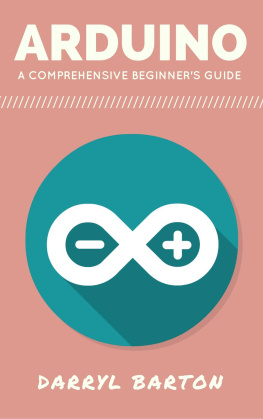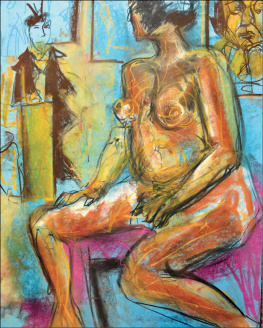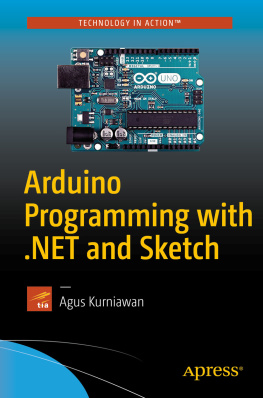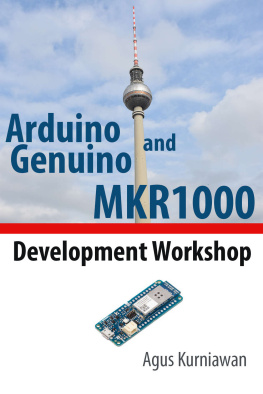John Boxall - Arduino Workshop
Here you can read online John Boxall - Arduino Workshop full text of the book (entire story) in english for free. Download pdf and epub, get meaning, cover and reviews about this ebook. year: 2021, publisher: No Starch Press, genre: Home and family. Description of the work, (preface) as well as reviews are available. Best literature library LitArk.com created for fans of good reading and offers a wide selection of genres:
Romance novel
Science fiction
Adventure
Detective
Science
History
Home and family
Prose
Art
Politics
Computer
Non-fiction
Religion
Business
Children
Humor
Choose a favorite category and find really read worthwhile books. Enjoy immersion in the world of imagination, feel the emotions of the characters or learn something new for yourself, make an fascinating discovery.
- Book:Arduino Workshop
- Author:
- Publisher:No Starch Press
- Genre:
- Year:2021
- Rating:3 / 5
- Favourites:Add to favourites
- Your mark:
- 60
- 1
- 2
- 3
- 4
- 5
Arduino Workshop: summary, description and annotation
We offer to read an annotation, description, summary or preface (depends on what the author of the book "Arduino Workshop" wrote himself). If you haven't found the necessary information about the book — write in the comments, we will try to find it.
Arduino Workshop — read online for free the complete book (whole text) full work
Below is the text of the book, divided by pages. System saving the place of the last page read, allows you to conveniently read the book "Arduino Workshop" online for free, without having to search again every time where you left off. Put a bookmark, and you can go to the page where you finished reading at any time.
Font size:
Interval:
Bookmark:

When it comes to technology, theres really something to be said for learning by example, and with each key point focused around a specific project, the information in this book is easy to learn and retain.
Dave Rankin, About.com Open Source
Arduino Workshop was the first book Ive read that helped me really make sense of the practical applications the Arduino is capable of.
AmateurRadio.com
A very thorough primer for those wishing to jump on the [Arduino] bandwagon.
Kevin Wierzbicki, Campus Circle
Ive checked out several Arduino primers, and found the best one for my purposes to be Arduino Workshop: A Hands-on Introduction with 65 Projects by John Boxall.
Jeff Rowe, MCADCafe.com Blog
A good book for getting started... I highly recommend it if youre thinking about getting into Arduino projects and youre brand new to this stuff.
Nathan Yau, FlowingData
2nd Edition
John Boxall

San Francisco
Arduino Workshop, 2nd Edition. Copyright 2021 by John Boxall.
All rights reserved. No part of this work may be reproduced or transmitted in any form or by any means, electronic or mechanical, including photocopying, recording, or by any information storage or retrieval system, without the prior written permission of the copyright owner and the publisher.
ISBN-13: 978-1-7185-0058-7 (print)
ISBN-13: 978-1-7185-0059-4 (ebook)
Publisher: William Pollock
Executive Editor: Barbara Yien
Production Editor: Rachel Monaghan
Developmental Editors: Patrick DiJusto and Nathan Heidelberger
Cover Illustration: Charlie Wylie
Interior Design: Octopod Studios
Technical Reviewer: Xander Soldaat
Copyeditor: Paula L. Fleming
Compositor: Happenstance Type-O-Rama
Proofreader: Rachel Head
Indexer: JoAnne Burek
Circuit diagrams made using Fritzing (http://fritzing.org/).
For information on book distributors or translations, please contact No Starch Press, Inc. directly:
No Starch Press, Inc.
245 8th Street, San Francisco, CA 94103
phone: 1-415-863-9900;
www.nostarch.com
The Library of Congress issued the following Cataloging-in-Publication Data for the first edition:
Boxall, John, 1975-Arduino workshop : a hands-on introduction with 65 projects / by John Boxall.pages cmIncludes index.ISBN-13: 978-1-59327-448-1ISBN-10: 1-59327-448-31. Arduino (Microcontroller) I. Title.TJ223.P76B68 2013629.895--dc232013008261
No Starch Press and the No Starch Press logo are registered trademarks of No Starch Press, Inc. Other product and company names mentioned herein may be the trademarks of their respective owners. Rather than use a trademark symbol with every occurrence of a trademarked name, we are using the names only in an editorial fashion and to the benefit of the trademark owner, with no intention of infringement of the trademark.
For the two people who have always believed in me: my mother and my dearest Kathleen
John Boxall has been in the electronics design, distribution, and e-commerce field for over 26 years. He has lately been writing Arduino tutorials, projects, and kit reviews during his spare time.
Xander Soldaat is a former Mindstorms Community Partner for LEGO MINDSTORMS. He was an IT infrastructure architect and engineer for 18 years before becoming a full-time software developer, first for Robomatter and VEX Robotics and now as an R&D engineer for an embedded Wi-Fi solutions provider. In his spare time, he likes to tinker with robots, 3D printing, and home-built retro-computers.
First of all, a huge thank you to the Arduino team: Massimo Banzi, David Cuartielles, Tom Igoe, Gianluca Martino, and David Mellis. Without your vision, thought, and hard work, none of this would have been possible.
Thank you to all the readers of the first edition for your feedback and constructive criticism.
Many thanks to my technical reviewer, Xander Soldaat, for his contributions and for having the tenacity to follow through with such a large project.
I also want to thank the following organizations for their images and encouragement: Adafruit, Keysight Technologies, Freetronics, PMD Way, Seeed Studio, Sharp Corporation, SparkFun, and Tronixlabs.
Furthermore, a big thanks to Freetronics and PMD Way for the use of their excellent hardware products. And thank you to all those who have contributed their time making Arduino libraries, which makes life much easier for everyone. Kudos and thanks to the Fritzing team for their open source circuit schematic design tool, which Ive used throughout this book.
Thanks also to the following people (in no particular order) from whom Ive received encouragement, inspiration, and support: Elizabeth Pryce, Jonathan Oxer, Philip Lindsay, Ken Shirriff, Nathan Kennedy, and David L. Jones.
Finally, thank you to everyone at No Starch Press for their efforts in this updated edition, including Patrick DiJusto for his editorial input, Dapinder Dosanjh and Nathan Heidelberger for their endless patience, Rachel Monaghan for guiding the book through the production process, Paula Fleming for copyediting, Rachel Head for proofreading, JoAnne Burek for indexing, and of course Bill Pollock for his support and guidance and for convincing me that sometimes there is a better way to explain something.
Getting Started
Have you ever looked at some gadget and wondered how it really worked? Maybe it was a remote control boat, an elevator, a vending machine, or an electronic toy. Or have you wanted to create your own robot or make electronic signals for a model railroad? Or perhaps youd like to capture and analyze weather data over time? Where and how do you start?
The Arduino microcontroller board (shown in ) can help you find the answers to some of the mysteries of electronics in a hands-on way. The original creation of Massimo Banzi and David Cuartielles, the Arduino system offers an inexpensive way to build interactive projects, such as remote-controlled robots, GPS tracking systems, and electronic games.
The Arduino project has grown exponentially since its introduction in 2005. Its now a thriving industry, supported by a community of people united with the common bond of creating something new. Youll find individuals and groups ranging from small clubs to local hackerspaces to educational institutions, all interested in trying to make things with the Arduino.

Figure 1-1: The Arduino board
To get a sense of the variety of Arduino projects in the wild, simply search the internet. There, youll find an incredible number of projects, blogs, experiences, and ideas that show what is possible with the Arduino.
A quick scan through this book will show you that you can use the Arduino to do something as simple as blinking a small light or something as complicated as interacting with a cellular phoneand many different things in between.
Font size:
Interval:
Bookmark:
Similar books «Arduino Workshop»
Look at similar books to Arduino Workshop. We have selected literature similar in name and meaning in the hope of providing readers with more options to find new, interesting, not yet read works.
Discussion, reviews of the book Arduino Workshop and just readers' own opinions. Leave your comments, write what you think about the work, its meaning or the main characters. Specify what exactly you liked and what you didn't like, and why you think so.

